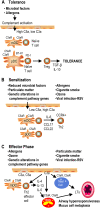Complement activation pathways: a bridge between innate and adaptive immune responses in asthma
- PMID: 17607007
- PMCID: PMC2647626
- DOI: 10.1513/pats.200704-046AW
Complement activation pathways: a bridge between innate and adaptive immune responses in asthma
Abstract
Although it is widely accepted that allergic asthma is driven by T helper type 2 (Th2)-polarized immune responses to innocuous environmental allergens, the mechanisms driving these aberrant immune responses remain elusive. Recent recognition of the importance of innate immune pathways in regulating adaptive immune responses have fueled investigation into the role of innate immune pathways in the pathogenesis of asthma. The phylogenetically ancient innate immune system, the complement system, is no exception. The emerging paradigm is that C3a production at the airway surface serves as a common pathway for the induction of Th2-mediated inflammatory responses to a variety of environmental triggers of asthma (i.e., allergens, pollutants, viral infections, cigarette smoke). In contrast, C5a plays a dual immunoregulatory role by protecting against the initial development of a Th2-polarized adaptive immune response via its ability to induce tolerogenic dendritic cell subsets. On the other hand, C5a drives type 2-mediated inflammatory responses once inflammation ensues. Thus, alterations in the balance of generation of the various components of the complement pathway either due to environmental exposure changes or genetic alterations in genes of the complement cascade may underlie the recent rise in asthma prevalence in westernized countries.
Figures

Similar articles
-
New insights into the role of the complement pathway in allergy and asthma.Curr Allergy Asthma Rep. 2005 Sep;5(5):362-9. doi: 10.1007/s11882-005-0007-y. Curr Allergy Asthma Rep. 2005. PMID: 16091207 Review.
-
The anaphylatoxins bridge innate and adaptive immune responses in allergic asthma.Mol Immunol. 2004 Jun;41(2-3):123-31. doi: 10.1016/j.molimm.2004.03.019. Mol Immunol. 2004. PMID: 15159057 Review.
-
A regulatory role for the C5a anaphylatoxin in type 2 immunity in asthma.J Clin Invest. 2006 Mar;116(3):783-96. doi: 10.1172/JCI26582. J Clin Invest. 2006. PMID: 16511606 Free PMC article.
-
Toll/IL-1 signaling is critical for house dust mite-specific helper T cell type 2 and type 17 [corrected] responses.Am J Respir Crit Care Med. 2009 May 15;179(10):883-93. doi: 10.1164/rccm.200806-974OC. Epub 2009 Feb 26. Am J Respir Crit Care Med. 2009. PMID: 19246719
-
Complement regulates inhalation tolerance at the dendritic cell/T cell interface.Mol Immunol. 2007 Jan;44(1-3):44-56. doi: 10.1016/j.molimm.2006.06.016. Epub 2006 Aug 4. Mol Immunol. 2007. PMID: 16889830 Review.
Cited by
-
Dysregulation of complement system and CD4+ T cell activation pathways implicated in allergic response.PLoS One. 2013 Oct 8;8(10):e74821. doi: 10.1371/journal.pone.0074821. eCollection 2013. PLoS One. 2013. PMID: 24116013 Free PMC article.
-
Deletion of the monkeypox virus inhibitor of complement enzymes locus impacts the adaptive immune response to monkeypox virus in a nonhuman primate model of infection.J Virol. 2011 Sep;85(18):9527-42. doi: 10.1128/JVI.00199-11. Epub 2011 Jul 13. J Virol. 2011. PMID: 21752919 Free PMC article.
-
The Value of Targeting Complement Components in Asthma.Medicina (Kaunas). 2020 Aug 12;56(8):405. doi: 10.3390/medicina56080405. Medicina (Kaunas). 2020. PMID: 32806638 Free PMC article.
-
Increased expression of ficolin-1 is associated with airway obstruction in asthma.BMC Pulm Med. 2023 Nov 24;23(1):470. doi: 10.1186/s12890-023-02772-2. BMC Pulm Med. 2023. PMID: 37996869 Free PMC article.
-
Airways exudation of plasma macromolecules: Innate defense, epithelial regeneration, and asthma.J Allergy Clin Immunol. 2019 Apr;143(4):1271-1286. doi: 10.1016/j.jaci.2018.07.037. Epub 2018 Aug 29. J Allergy Clin Immunol. 2019. PMID: 30170125 Free PMC article. Review.
References
-
- Wills-Karp M, Ewart SL. Time to draw breath: asthma-susceptibility genes are identified. Nat Rev Genet 2004;5:376–387. - PubMed
-
- Wills-Karp M. Immunologic basis of antigen-induced airway hyperresponsiveness. Annu Rev Immunol 1999;17:255–281. - PubMed
-
- Carroll MC. The complement system in regulation of adaptive immunity. Nat Immunol 2004;5:981–986. - PubMed
-
- Köhl J, Wills-Karp M. Complement regulates inhalation tolerance at the dendritic cell/T cell interface. Mol Immunol 2007;44:44–56. - PubMed
-
- Köhl J. The role of complement in danger sensing and transmission. Immunol Res 2006;34:157–176. - PubMed
Publication types
MeSH terms
Substances
Grants and funding
LinkOut - more resources
Full Text Sources
Other Literature Sources
Medical
